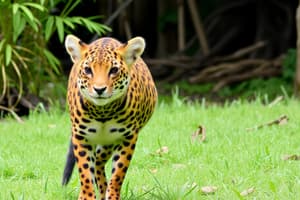Podcast
Questions and Answers
What is the symbol of the World Wide Fund for Nature, and why is it significant?
What is the symbol of the World Wide Fund for Nature, and why is it significant?
The symbol is a giant panda, significant due to its popularity that helps raise funds for conservation.
Why are invertebrates often overlooked in conservation efforts?
Why are invertebrates often overlooked in conservation efforts?
Invertebrates make up over 90% of all creatures but receive only a tiny percentage of funding due to being less well-known.
What unique adaptations does the blobfish have to survive in its deep ocean habitat?
What unique adaptations does the blobfish have to survive in its deep ocean habitat?
The blobfish has tiny fins and no skeleton, allowing it to withstand high water pressure.
How has the population of pangolins in China changed since the 1960s?
How has the population of pangolins in China changed since the 1960s?
What makes the aye aye creature vulnerable to extinction?
What makes the aye aye creature vulnerable to extinction?
What role do fishing boats play in the plight of the blobfish?
What role do fishing boats play in the plight of the blobfish?
In what way are pangolins unique among mammals?
In what way are pangolins unique among mammals?
Why might less attractive animals be more at risk of extinction?
Why might less attractive animals be more at risk of extinction?
Why are other endangered species not getting enough research attention?
Why are other endangered species not getting enough research attention?
Where do aye ayes primarily live, and when are they most active?
Where do aye ayes primarily live, and when are they most active?
Flashcards are hidden until you start studying
Study Notes
### The WWF's Symbol and Endangered Species
- The World Wide Fund for Nature (WWF) uses the giant panda as its symbol because of the animal’s cuteness and popularity, which helps the organization raise money for endangered species.
- Invertebrates, which make up over 90% of all creatures on Earth, receive only a tiny percentage of funding for wildlife protection.
- This means that less well-known or less "exciting" creatures are more likely to become extinct.
The Blobfish and Accidental Extinction
- The blobfish is an example of a creature many consider ugly, with its tiny eyes, big mouth, and slimy pink body.
- Found deep in the ocean, the blobfish has tiny fins and no skeleton to withstand the high water pressure.
- These fish are accidentally caught in fishing nets designed to capture other fish and crustaceans.
The Pangolin and Targeted Extinction
- The pangolin, unique among mammals for its reptile-like scales, is the most targeted animal by poachers worldwide.
- Its scales are highly prized in traditional Chinese medicine, which has caused the population to decline by around 90% since the 1960s.
- While its scales protect it from natural predators, they make the pangolin vulnerable to poachers.
The Aye-Aye and Extinction Based on Perception
- The aye-aye, the world’s largest nocturnal primate found only in Madagascar, is often killed because of its appearance.
- Despite being furry, harmless, solitary creatures, they are perceived as ugly.
- The aye-aye sleeps in tree nests during the day and hunts at night.
Studying That Suits You
Use AI to generate personalized quizzes and flashcards to suit your learning preferences.





